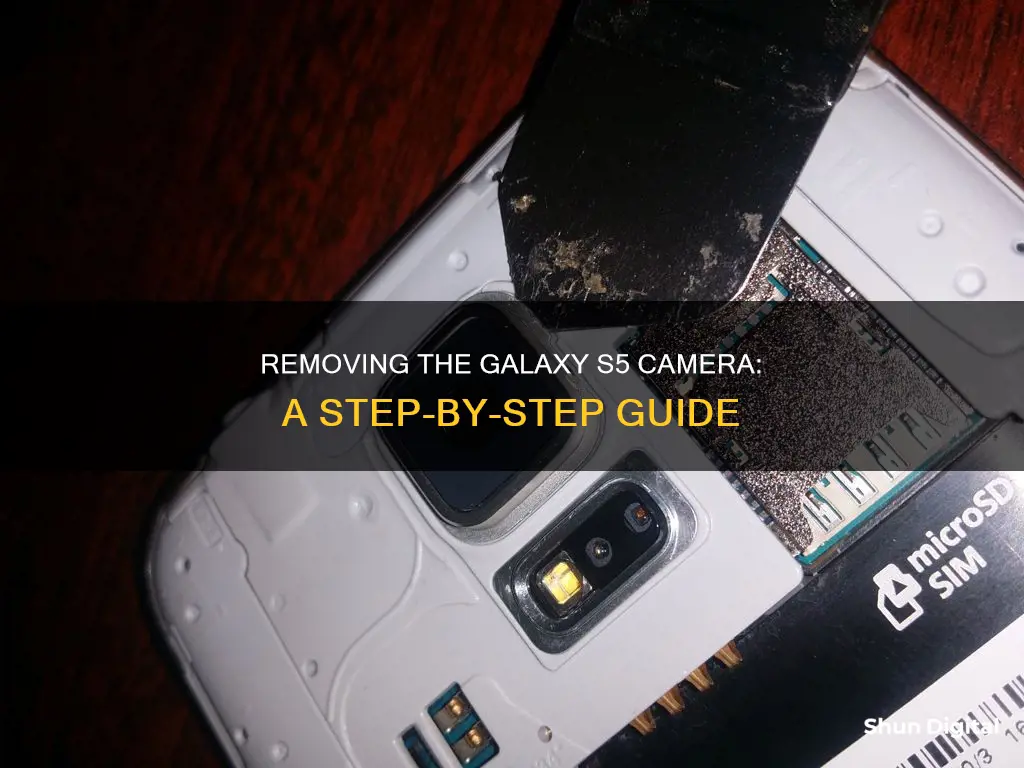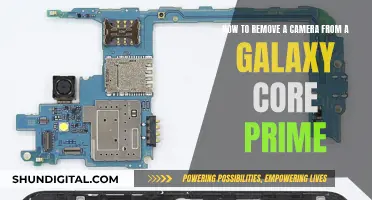
If you need to replace the rear-facing camera on your Samsung Galaxy S5, you're in luck—there are plenty of online guides to help you do it. It's a delicate process that involves prying and twisting the rear cover off the back of the phone, removing the battery, microSD card, and SIM card, and carefully disconnecting the relevant cables and connectors. You'll need tools like tweezers, a spudger, and an iOpener to warm and loosen the adhesive. With patience and precision, you can successfully detach the old camera and install a new one.
What You'll Learn

Removing the rear-facing camera
To remove the rear-facing camera from your Samsung Galaxy S5, you will need to first remove the back cover of the phone. You can do this by inserting a fingernail or plastic opening tool into the divot to the left of the camera and gently prying and twisting the flexible rear cover off. Once the cover is removed, you will need to remove the battery, microSD card, and SIM card.
With these components removed, you can now access the motherboard. Use a plastic opening tool or spudger to pry off the rear-facing camera from the motherboard. Be careful not to damage any of the surrounding components. Once the camera is removed from the motherboard, you can now replace it with a new one or make any necessary repairs.
It is important to note that you should only attempt to remove the rear-facing camera from your Samsung Galaxy S5 if you are comfortable with disassembling your phone and working with delicate electronic components. If you are unsure or uncomfortable with any part of the process, it is best to seek the help of a professional or skilled technician.
Additionally, when reassembling your device, follow the disassembly instructions in reverse order. Ensure that all components are securely connected and fastened before turning on your device and testing the camera.
ProctorU: Exam Surveillance Through Your Camera Lens
You may want to see also

Using a plastic opening tool
To remove the camera from your Samsung Galaxy S5, you will need a plastic opening tool and a flat plastic prying tool.
First, power off your phone. Then, insert a fingernail or the plastic opening tool into the divot to the left of the rear-facing camera. Gently pry and twist the flexible rear cover off the back of the phone.
Next, insert the plastic opening tool into the recess in the bottom right corner of the battery and lift it upward to remove the battery. With your fingertip, pull the microSD card straight down out of its slot and remove it. Repeat this step to remove the SIM card.
Now, use the plastic opening tool to pry up the plastic midframe connector panel. Remove the connector panel with a pair of tweezers.
At this point, you will need to use a hair dryer or heat gun to heat up the adhesive securing the display assembly to the rest of the phone. Place a heated iOpener on the left side of the phone for at least 90 seconds, then reheat and place it on the right half of the phone.
Use an opening pick to separate the adhesive securing the front panel glass. Insert the edge of the opening pick underneath the bottom right side of the front glass. Slide the pick up along the right side of the display, carefully slide it around the corner, stopping before the speaker grille at the top of the phone. The adhesive securing the top of the phone is only a narrow strip above the earpiece speaker, so slide the pick along the top of the speaker to avoid damaging internal components.
Slide the opening pick across the top of the phone, being very careful not to insert the pick too deeply. Carefully slide the pick around the upper left corner. If you encounter any resistance from cooling adhesive, reapply a heated iOpener to the left side of the phone.
Slide the opening pick down along the left half of the phone, stopping at the lower left corner. Slide the pick all the way to the bottom left corner of the phone, making sure it is securely placed.
Now, place a reheated iOpener over the bottom portion of the display assembly. There are delicate components in this portion of the phone, so ensure the adhesive is warm and easy to loosen to protect the phone. The bottom end of the phone contains the soft button and home button ribbon cables, so be careful not to insert the opening pick too far and risk cutting these cables.
Slide the very end of the opening pick across the bottom edge of the display to separate the remaining adhesive. Twist the opening pick to detach the glass from the phone. If the front panel does not detach easily, you may need to cut the adhesive further or separate the adhesive on the soft button cable.
Insert an opening pick under the soft button icons on the display and pry the button cables down off the inside of the front panel. Slightly lift, but do not remove, the home button end of the display assembly. Do not remove the front panel entirely, as it is still attached by a connector.
If you are reusing the home button flex cable, be careful not to sever the cable from the home button. Adhesive can cause the cable to rip apart from the home button, and while the home button will still work, the fingerprint scanner will not.
Now, use the sharp tip of a spudger to lift the front panel assembly cable connector straight up off its socket on the motherboard. Safely remove the front panel assembly from the phone.
Remove the ten 3.4 mm Phillips #000 screws from the display side of the midframe. Flip the phone over and remove the following screws from the battery side of the midframe: two 4.4 mm Phillips #000 screws near the USB port and one 4.4 mm Phillips #000 screw.
Gently run a plastic opening tool down along the left inner side of the interior frame to separate the three white plastic clips. The midframe is composed of two halves that encase the motherboard. Gently pull the long sides of the silver bezel out and away from the phone to separate the two halves of the midframe.
It may be helpful to gently push in from the inside of the battery compartment, but be careful not to flex the interior half of the midframe, as the motherboard is mounted to it. Continue on to the right side of the silver bezel, pulling away from the interior section of the midframe to separate the two halves.
Use a plastic opening tool to pry any remaining corners out of the silver bezel. Carefully remove the interior midframe/motherboard assembly from the white inner midframe.
Now, remove the single 3.0 mm Phillips #00 screw securing the motherboard to the midframe. Pull, but do not remove, the motherboard away from the midframe to allow access to the connectors on the rear. Do not attempt to fully remove the motherboard as it is still attached to the interior midframe by the Micro-USB port daughterboard connector.
Lay the motherboard on a clean, flat surface and support the interior midframe with one hand, leaving the other hand free to work on the motherboard assembly.
Finally, use the flat end of a spudger to disconnect the rear-facing camera connector straight up from its socket on the motherboard. Remove the rear-facing camera from the motherboard using a pair of tweezers.
Your Samsung Galaxy S5's camera has now been successfully removed!
Setting Up Swann Camera System: A Step-by-Step Guide
You may want to see also

Removing the battery
To remove the battery from a Samsung Galaxy S5, you will need to take some safety precautions if your battery is swollen. Then, follow these steps:
Firstly, insert your fingernail or a plastic opening tool into the divot to the left of the rear-facing camera. Gently pry and twist the flexible rear cover off the back of the phone. Now, insert your fingernail or plastic opening tool into the recess in the bottom right corner of the battery and lift it upward. Finally, remove the battery away from the phone.
To reassemble your device, simply follow these instructions in reverse.
Casting Your Geeni Camera to TV: A Simple Guide
You may want to see also

Removing the SIM card
To remove the SIM card from your Samsung Galaxy S5, you'll first need to remove the rear cover and battery. Start by inserting a fingernail or plastic opening tool into the divot to the left of the rear-facing camera. Gently pry and twist the flexible rear cover off the back of the phone. Then, insert your fingernail or the plastic opening tool into the recess in the bottom right corner of the battery and lift it upward to remove it.
With the battery removed, you'll now have access to the SIM card slot. Using your fingertip, pull the SIM card straight down out of its slot. Be gentle and careful during this step to avoid damaging the SIM card or its slot.
If your SIM card is particularly difficult to remove, you may need to use a plastic opening tool to gently pry it out. However, be extra cautious when doing so to avoid causing any damage.
Once the SIM card is removed, keep it in a safe place, as it contains important information such as your phone number and contact list.
To reassemble your device and insert a new SIM card, simply follow the above steps in reverse. Ensure that the SIM card is correctly aligned with its slot before pushing it gently into place.
Galaxy Watch Camera Features: What You Need to Know
You may want to see also

Disconnecting the camera's connector
To disconnect the camera connector, you will need a spudger. This is a tool with a flat end and a sharp tip. It is used to separate components and lift connectors without causing damage.
Firstly, locate the rear-facing camera connector on the motherboard. This will be a small socket with a cable attached, connected to the rear-facing camera. Gently insert the flat end of the spudger underneath the connector, prying it straight up and away from the motherboard. You may need to wiggle the spudger slightly to loosen the connector, but be careful not to apply too much force, as you could damage the socket or the cable.
Once the connector is loose, carefully lift it away from the motherboard with the spudger or your fingers. Ensure that you are only pulling on the connector itself and not the cable, as this could cause damage. With the connector disconnected, you can now remove the camera from the motherboard using a pair of tweezers.
If you are replacing the camera, ensure that you follow the correct procedure to reassemble the phone, including reattaching the connector to the new camera. It is important to be gentle and precise during this process to avoid damaging any internal components.
When disconnecting and reconnecting connectors, it is important to work slowly and carefully. These connectors are delicate and can be easily damaged if too much force is applied. Take your time and ensure that you are only handling the connector itself, not the cable or socket.
The FBI and Cameras: Spying on Citizens?
You may want to see also
Frequently asked questions
To remove the rear-facing camera from your Samsung Galaxy S5, you will need to first insert a fingernail or plastic opening tool into the divot to the left of the camera. Gently pry and twist the flexible rear cover off the back of the phone. Next, use a fingertip to pull out and remove the microSD card, and repeat the process to remove the SIM card. Then, remove the connector panel with a pair of tweezers. Finally, use the flat end of a spudger to disconnect the rear-facing camera connector from its socket on the motherboard, and remove the camera with tweezers.
You will need a plastic opening tool, a pair of tweezers, and a spudger.
Use the flat end of a spudger to gently pry the camera connector straight up from its socket on the motherboard.







